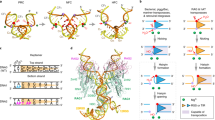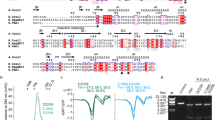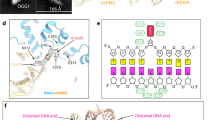Abstract
Bovine pancreatic deoxyribonuclease I (DNase I), an endonuclease that degrades double-stranded DNA in a nonspecific but sequence-dependent manner1–4, has been used as a biochemical tool in various reactions, in particular as a probe for the structure of chromatin and for the helical periodicity of DNA on the nucleosome and in solution5–10. Limited digestion by DNase I, termed DNase I ‘foot-printing’, is routinely used to detect protected regions in DNA–protein complexes11. Recently, we have solved the three-dimensional structure of this glycoprotein (relative molecular mass 30,400) by X-ray structure analysis at 2.5 Å resolution12 and have subsequently refined it crystallographically at 2.0 Å (ref. 26). Based on the refined structure and the binding of Ca2+–thymidine 3′,5′-diphosphate (Ca-pTp) at the active site12, we propose a mechanism of action and present a model for the interaction of DNase I with double-stranded DNA that involves the binding of an exposed loop region in the minor groove of B-DNA and electrostatic interactions of phosphates from both strands with arginine and lysine residues on either side of this loop. We explain DNase I cleavage patterns in terms of this model and discuss the consequences of the extended DNase I–DNA contact region for the interpretation of DNase I footprinting results.
This is a preview of subscription content, access via your institution
Access options
Subscribe to this journal
Receive 51 print issues and online access
$199.00 per year
only $3.90 per issue
Buy this article
- Purchase on SpringerLink
- Instant access to full article PDF
Prices may be subject to local taxes which are calculated during checkout
Similar content being viewed by others
References
Laskowski, M. Enzymes 4, 289–311 (1971).
Bernardi, G., Ehrlich, S. D. & Thiery, J. P. Nature new Biol. 246, 36–40 (1973).
Lomonossoff, G. P., Butler, P. J. G. & Klug, A. J. molec. Biol. 149, 745–760 (1981).
Drew, H. R. & Travers, A. A. Cell 37, 491–502 (1984).
Moore, S. Enzymes 14, 287–296 (1981).
Noll, M. Nucleic Acids Res. 1, 1573–1578 (1974).
Sollner-Webb, B. & Felsenfeld, G. Cell 10, 537–547 (1977).
Prunell, A. et al. Science 204, 855–858 (1979).
Klug, A. & Lutter, L. C. Nucleic Acids Res. 9, 4267–4283 (1981).
Rhodes, D. & Klug, A. Nature 286, 573–578 (1980).
Galas, J. D. & Schmidtz, A. Nucleic Acids Res. 5, 3157–3170 (1978).
Suck, D., Oefner, C. & Kabsch, W. EMBO J. 3, 2423–2430 (1984).
Liao, T. H. J. biol. Chem. 250, 3721–3724 (1975).
Liao, T. H., Salnikow, J., Moore, S. & Stein, W. H. J. biol. Chem. 248, 1489–1495 (1973).
Perutz, M. F., Gronenborn, A. M., Clore, G. M., Fogg, J. H. & Shih, D. T.-b. J. molec. Biol. 183, 491–498 (1985).
Mehdi, S. & Gerlt, J. A. Biochemistry 23, 4844–4852 (1984).
Price, P. A., Moore, S. & Stein, W. H. J. biol. Chem. 244, 924–928 (1969).
Price, P. A., Stein, W. H. & Moore, S. J. biol. Chem. 244, 929–932 (1969).
Hugli, T. E. & Stein, W. H. J. biol. Chem. 246, 7191–7200 (1971).
Kopka, M. L., Yoon, C., Goodsell, D., Pjura, P. & Dickerson, R. E. J. molec. Biol. 183, 553–563 (1985).
Drew, H. R. J. molec. Biol. 176, 535–557 (1984).
McCall, M., Brown, T. & Kennard, O. J. molec. Biol. 183, 385–396 (1985).
Fratini, A. V., Kopka, M. L., Drew, H. R. & Dickerson, R. E. J. biol. Chem. 257, 14686–14707 (1982).
Van Dyke, M. M. & Dervan, P. B. Science 225, 1122–1127 (1984).
Möller, A., Nordheim, A., Kozlowski, S. A., Patel, D. J. & Rich, A. Biochemistry 23, 54–62 (1984).
Oefner, C. & Suck, D. (submitted).
Author information
Authors and Affiliations
Rights and permissions
About this article
Cite this article
Suck, D., Oefner, C. Structure of DNase I at 2.0 Å resolution suggests a mechanism for binding to and cutting DNA. Nature 321, 620–625 (1986). https://doi.org/10.1038/321620a0
Received:
Accepted:
Issue Date:
DOI: https://doi.org/10.1038/321620a0
This article is cited by
-
Bacteria-mediated resistance of neutrophil extracellular traps to enzymatic degradation drives the formation of dental calculi
Nature Biomedical Engineering (2024)
-
Propidium iodide staining underestimates viability of adherent bacterial cells
Scientific Reports (2019)
-
Organochlorinated pesticides expedite the enzymatic degradation of DNA
Communications Biology (2019)
-
Structural basis of Mcm2–7 replicative helicase loading by ORC–Cdc6 and Cdt1
Nature Structural & Molecular Biology (2017)
-
The First Small-Molecule Inhibitors of Members of the Ribonuclease E Family
Scientific Reports (2015)



